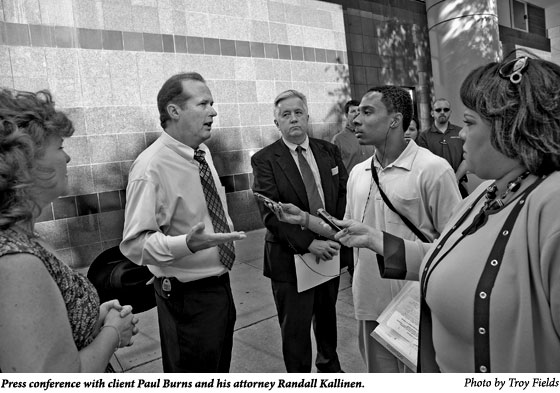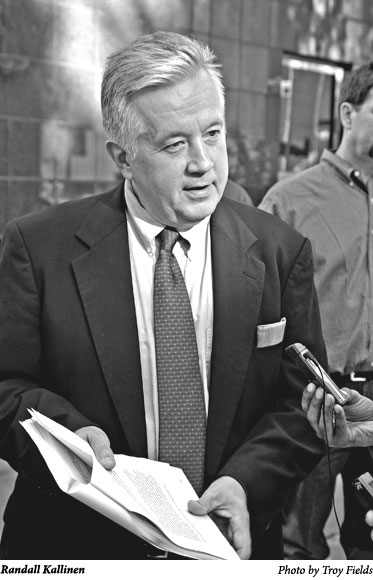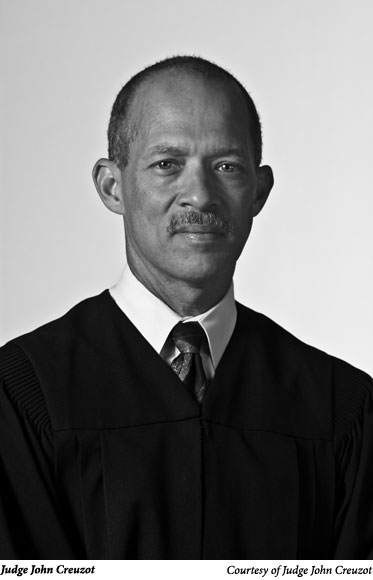The Power of Drug Courts
Drug courts can keep addicts in treatment and out of jail — if judges let them

For nearly 20 years, Joel Bennett shuttled drug addicts through courtrooms. He dutifully sent them off to prison, first as a prosecutor and later as a state district judge in Austin, though he knew he was accomplishing little. Incarceration wouldn’t puncture their addiction. They would use again. Predictably, case files bearing familiar names would pile again on his desk. A sense of futility hung over the exercise. “What I saw was the same people returning to the system over and over again. And their children coming into the system,” Bennett says. “No one talked about breaking the cycle of crime.” Bennett recognized, as an ever-growing number of judges do, that to keep drug offenders from landing back in prison, he had to help addicts free themselves from the fog of substance abuse.
Bennett and Leon Grizzard are the two judges who oversee Travis County’s drug diversion court. They steer addicts into a court-supervised treatment program instead of prison. In the past decade, drug courts like the one in Travis County have successfully handled nonviolent defendants with drug and alcohol addictions-if success is defined as increasing public safety at the least cost to the taxpayer. People who complete drug-court programs rarely tumble back into substance abuse. According to four drug-court judges surveyed, about 10 percent of program graduates commit new crimes-a recidivism rate roughly one-fifth that of traditional probation routines. That means drug courts can ease the strain on overcrowded prisons and save taxpayer money. A study of the Dallas drug court by Southern Methodist University showed that every government dollar spent on diversion courts saved taxpayers more than $9.
Though criminal justice reform groups have advocated drug courts for years, Texas until recently lagged behind the rest of the country. There are more than 1,200 drug courts nationwide, according to the U.S. Department of Justice. At one time, tiny Delaware had more drug courts than the Lone Star State. But Texas’ bulging prison system is forcing Texas to catch up. Drug courts in Texas have ballooned from three in 2002 to 35 in 2007. The movement has sprung organically from the bottom up: Judges, prosecutors, counselors, and county officials have volunteered to create the programs in their jurisdictions. “Anyone who hears this becomes an advocate for it,” says Ana Yáñez-Correa, executive director of the Texas Criminal Justice Coalition. “It’s been a domino effect.”
More drug courts are on the way. Last spring, the Texas Legislature passed a bill requiring all counties with populations exceeding 200,000 to institute a drug court. The bill is expected to divert more than 2,300 addicts away from prisons during the next few years. In late October, Gov. Rick Perry awarded $4.4 million in state grants to drug courts, a much-needed boost in funding.
But as drug courts become more widespread, it appears that-like the narcotics they were created to fight-the courts can be abused. State and federal governments have instituted few regulations and set up no oversight. Judges have wide latitude to decide people’s fates. In the hands of the right judges, the drug court model performs marvelously. Other judges appear to have trouble reconciling their punitive role with this new therapeutic one. The U.S. Department of Justice designed a set of guidelines and best practices-but they’re the criminal justice equivalent of blueprints without building codes. The guidelines suggest that judges receive ongoing training and partner with treatment programs and community groups.
Because drug courts grow mostly from the local level, there is little standardization. Texas law broadly defines a drug court, but places hardly any restrictions on what judges can do. There is no oversight specifically for the drug courts. A recent case in Houston demonstrates the potential risks behind the courts’ expansion. Judge K. Michael Mayes of Montgomery County is facing a federal lawsuit by a defendant who claims his treatment in Mayes’ drug court was arbitrary and violated his rights to due process.
“The issue is following best practices,” Yáñez-Correa says. In 2005, the group worked successfully with legislators to add to the budget bill some loosely standardized requirements for drug courts. Ostensibly, if a program takes state money, it’s required to follow the Justice Department’s broad guidelines for drug courts, including a recommendation that defense attorneys be present at all hearings. “We’ve taken the first step to make sure there is an expansion of the drug courts,” she says. “Now, as the program increases, those who haven’t tried it before need technical assistance from judges who are doing it right.”
On a Wednesday night in early November, recovering addicts streamed into a drab courtroom in downtown Austin for their regular drug court session. The court, the second-oldest in Texas, has been in operation since 1993. Seated in the audience was a young, diverse crowd: white, black, and Latino; rich and poor; businessmen; college students; and manual laborers. Judge Bennett took the bench. On this night, the first order of business was a graduation. Each drug court is different-localities design their own programs and decide who can be admitted to them-but the foundations are the same. Prosecutors or judges refer nonviolent addicts or alcoholics to drug courts, which oversee treatment. Judges, along with teams of probation officers, attorneys, counselors, and family members, monitor each addict’s progress. On average, it takes 22 months for defendants to complete the Austin program’s three phases, after which their charges will be dismissed and, in some cases, expunged. If graduates remain clean, it can be as if they were never arrested.
The bailiff called a name, and a young black man with braided hair in a red button-down shirt, tie, and black pants rose and walked before Bennett. (Drug courts are confidential, and the Observer was allowed to witness the proceedings on the condition that participants’ names wouldn’t be printed.) “I know you’ve thought a lot about what you wanted to say,” Bennett said. “Now I want you to address the group.” The young man turned to face a roomful of fellow recovering addicts. His feet poked at the carpet. He clasped his hands behind his back.
“These people are really here to help you,” he said. “I used to see it as a burden. Now I see it as a blessing.” He looked sheepishly at Bennett. “Is that enough?” he whispered.
“No, that’s not enough,” Bennett bellowed. The audience laughed. The young man stumbled on for another minute, describing the stubbornness of his addiction, until Bennett smiled. “OK, I’m proud of you. Let’s give him a hand. He’s done a great job.” Everyone applauded. The young man walked through the courtroom’s double doors and, perhaps, into a life clear of addiction-or so Bennett hopes. Though drug courts offer a way to avoid prison time, the programs can be demanding: several counseling sessions a week, community service, weekly random drug tests, support group meetings, and frequent appearances before the judge are common. If a defendant stumbles, the judge can send them to jail for several days. If someone drops out, they likely will end up in prison.
Bennett questioned defendants in various stages of the program. They stood alone, directly in front of the bench, like kids before the teacher’s desk. Drug court sessions are part probation hearing and part counseling session. The jagged edge of law enforcement blends with the encouragement of 12-step recovery programs. The result is addicts standing before judges, prosecutors, and probation officers-people who normally try to put them away-to divulge the most intimate and important details of their lives. During visits to hearings in several Texas cities, the Observer witnessed a woman ask a judge for help with a divorce, and another who inquired if having a child would impact her recovery. Several participants asked for help finding jobs.
“You’re studying for your GED? How’s that going?” Bennett asked one man in a striped shirt. Another wanted permission to travel to Houston to see his family for Thanksgiving, which Bennett grudgingly approved as long as the man kept up his community service. The random drug tests don’t halt for the holidays, either.
Next, Bennett brought forward a short, white youth who, despite several stints of rigorous inpatient drug treatment, had just tested positive for marijuana on his first urine sample in the program. “It’s like you haven’t learned anything,” Bennett yelled at him. “Each time you use, you’re going to jail. I’ve done that before.” As the kid slinked away, the judge eased back into a warmer tone: “Let’s give him a hand to encourage him.” Everyone clapped.
In Corpus Christi, District Judge Sandra Watts has run the drug court for nearly four years. Her intimate, Tuesday-night court sessions have become known as “Tuesdays with Sandra.” She says, “I’m a different judge on Tuesday nights than I am during the day. There is a different philosophy when you’re running a drug court. There is a rapport being developed between the participants and the judge. I know a lot about their lives.”
In the last 10 years, District Judge John Creuzot has molded Dallas County’s drug court into one of the most extensive and successful diversion programs in the state. (Watts referred to him as the drug court “granddaddy.”) In Dallas, addicts receive a clinical assessment when they enter the program to determine the kind of treatment they need, including mental health assistance. Many drug courts attempt to treat the root of the defendant’s addiction. But with the ability to refer addicts to a wider range of treatment facilities, Dallas may have the model program. The essential element that such courts must share, Creuzot says, is that treatment cannot work unless a judge connects with an addict.
“The point is to get as far in [to people’s lives] as you can, and to get to know them,” he says. “It’s a different mind-set. You have to be engaged in who they are … what their strengths and weaknesses are. Not everyone wants to do that.
“You have to develop trust between them and you. They have to trust that you’re making decisions in their best interests, because they’re not accustomed to that in the criminal justice system. Nobody is, really. They have to get to know you and trust you and the decisions you’re making on their behalf.”
Violating the rules of a program might land some participants in jail for the weekend to set them straight. But Austin’s Judge Bennett says it’s important not to punish too severely. “I’m not trying to break them down,” he says. “I’m trying to build them back up. I want them to feel better about themselves.”

Paul Burns never considered himself an addict, though he concedes he drank too often. At 46, Burns lives near Conroe, a growing exurb north of Houston, with his wife and four kids. He operates a small oil company-it has eight wells-along with several other small businesses.
His trouble with drug court began last April. Burns-already on probation for a minor drug possession charge-submitted a urine sample that tested positive for alcohol, a violation of his probation. Judge Mayes of Montgomery County’s 410th District Court gave Burns a choice: Enter Mayes’ drug court treatment program, or the judge would revoke Burns’ probation and send him to prison for several years. Burns didn’t see that as much of a choice. He joined Mayes’ Substance Abuse Program. In addition to counseling and support group sessions, offenders in the program must submit to several random urine tests each month. On July 5, Burns was called in for a random drug test. His sample tested negative for drugs and alcohol, according to court records, but the sample was labeled “dilute,” which means, essentially, it was watered down. (Addicts sometimes try to dilute their urine to mask evidence of drug use.) Under Mayes’ strict policies, anyone submitting a diluted urine sample is immediately hauled off to jail, without a hearing to explain themselves to the judge.
Burns contends he’s been sober for eight months. He says he skipped breakfast on the morning of his urine test and drank several cups of coffee, which diluted his urine. He was shocked it landed him in jail.
Burns remained there for 44 days, until late August. Five others in Mayes’ program have been jailed in recent months because of a diluted urine sample, according to court records. Burns also claims that Mayes barred him from contacting his family during his stint in the county lockup.
His lawsuit, filed in federal court, contends that his jailing without an opportunity to challenge his detention or go before a judge violated his constitutional right to due process. Normally, judges have wide discretion in handling offenders on probation. But Randall Kallinen, a Houston civil rights attorney who’s representing Burns, argues that probation requirements can’t violate someone’s civil rights. “There’s nothing in the Code of Criminal Procedure that says you can’t give an African American two extra years in prison because he’s an African American. That’s not written down anywhere, but everyone knows federal law won’t allow it. It’s a civil rights violation.”

Mayes has refused to comment on the suit. He didn’t return two calls from the Observer seeking comment. But when the Observer visited Mayes’ court in early November-before the lawsuit was filed-the judge argued that his policies helped free offenders from their addictions. Mayes’ program does boast a record of success. Of the 41 people who have graduated from his program, he says not a single one has committed another drug offense. Several offenders in the drug court that morning sobbed and effusively thanked Mayes for helping them fight addiction and stay out of jail.
“The immediate sanction, immediate consequence is huge. Everyone in the program knows it,” Mayes says. “Probation officers know in this court that if somebody has a [urine test] that looks like it’s diluted or maybe it’s a positive, they don’t file motions and wait for me to sign something. They immediately type up a one-page sheet-order of arrest-and we sign.
“Here’s my philosophy: You’re on probation. I don’t have to prove you’re dirty; you have to prove to me you’re clean. You know why that’s so fair? This is what I tell them: Let’s say you apply for a job, you’re going to have to prove to them you’re clean, sober, doing well. So when you get out in the real world, you can handle the real heat. So that’s why we have the immediate consequence. I just decide how long I’m going to put them in jail. There’s always a consequence, and it’s always immediate. Otherwise, it just doesn’t have any impact.” Numerous law enforcement sources around the state say that dilute urine samples may-emphasis on may-indicate drug use or suspicious activity. Toxicologists say it is possible for addicts to mask drug use by diluting their urine, either by drinking a lot of water or taking pills that purportedly dilute urine enough to pass the test.
Other judges find Mayes’ methods overly harsh. All the other drug court judges interviewed for this story said they never jail an offender for dilute urine alone, simply because dilute urine has many causes, including overhydrati
n. A dilute sample will lead to tight
r scrutiny-more random drug screening, careful attention to the person’s performance-to watch for signs they may be relapsing. In most drug courts, an offender must fail at least two drug tests to spend even a weekend in jail.
For Mayes, a dilute sample is a violation, period. His drug court program forbids dilute urine for any reason. He said he would jail offenders in his program for dilute urine even if they actually were clean.
“Some people, let’s say, drink a lot of water-it’s a legitimate dilute. [I] still don’t care,” Mayes says. “A lot of guys say, well, I work out in the sun, I drink a lot of water. I say too bad. … But here’s what Auggie [program counselor Agustin Gutierrez] tells them: You can avoid that-vitamins, multivitamins. Pregnant women, there’s some kind of vitamin he gives them. In other words, if you’re clean, you can keep yourself healthy enough so you won’t have a dilute problem.”

Judge Creuzot in Dallas finds Mayes’ approach exceedingly harsh. “We just don’t throw people in jail,” he says. In fact, long jail stints can be self-defeating-Creuzot says most research shows that jail terms longer than about five days for drug court offenders can be harmful-isolating someone who needs support.
Judge Watts pointed out that defense attorneys are present at all her drug court hearings to guard offenders’ rights to due process. In fact, drug court guidelines issued by the Department of Justice stipulate that defense attorneys be present at all hearings. No defense counsel was present when the Observer witnessed a session in Mayes’ court on November 6.
Still, the judges interviewed for this story said lawmakers shouldn’t place any restrictions on drug courts. “Judges and the community should decide what works best for that community,” Bennett says.
Travis County District Attorney Ronnie Earle, who helps refer cases to Bennett’s court, put it this way: “You can’t make the list [of restrictions] long enough for a half-wit judge. A wise judge doesn’t need a list.”


